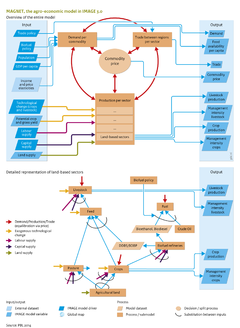Agricultural economy: Difference between revisions
Jump to navigation
Jump to search
No edit summary |
No edit summary |
||
| Line 9: | Line 9: | ||
|Description=As a result of the growing world population and higher per capita consumption, production of food, feed, fibres and other products, such as bio-energy and timber will need to increase rapidly in the coming decades. Even with the expected improvements in agricultural yields and efficiency, there will be increasing demand for more agricultural land. However expansion of agricultural land will lead to increases in greenhouse gas emissions, loss of biodiversity and ecosystem services, and nutrient imbalances. To reduce these environmental impacts, action is needed urgently to increase agricultural yields further and to reduce deforestation requires political support. | |Description=As a result of the growing world population and higher per capita consumption, production of food, feed, fibres and other products, such as bio-energy and timber will need to increase rapidly in the coming decades. Even with the expected improvements in agricultural yields and efficiency, there will be increasing demand for more agricultural land. However expansion of agricultural land will lead to increases in greenhouse gas emissions, loss of biodiversity and ecosystem services, and nutrient imbalances. To reduce these environmental impacts, action is needed urgently to increase agricultural yields further and to reduce deforestation requires political support. | ||
In IMAGE, future development of the agricultural economy can be calculated using the agro-economic model [[MAGNET model|MAGNET]] (formerly LEITAP) ([[Woltjer et al., 2011]]). MAGNET is a computable general equilibrium ([[CGE]]) model that is connected via a soft link to the core model of IMAGE. | |||
Demographic changes and rising incomes are the primary driving factors of the model, and lead to increasing and changing demand for all commodities including agricultural commodities. In response to changing demand, agricultural production is increasing, and the model also takes into account changing prices of production factors, resource availability and technological progress. In MAGNET, agricultural production supplies domestic markets, and other countries and regions are supplied via international trade, depending on historical trade balances, competitiveness (relative price developments), transport costs and trade policies. | Demographic changes and rising incomes are the primary driving factors of the model, and lead to increasing and changing demand for all commodities including agricultural commodities. In response to changing demand, agricultural production is increasing, and the model also takes into account changing prices of production factors, resource availability and technological progress. In MAGNET, agricultural production supplies domestic markets, and other countries and regions are supplied via international trade, depending on historical trade balances, competitiveness (relative price developments), transport costs and trade policies. | ||
Revision as of 13:00, 12 February 2014
Parts of Agricultural economy
| Component is implemented in: |
|
| Related IMAGE components |
| Projects/Applications |
| Key publications |
| References |
Key policy issues
- What is the area of cropland and grassland required to support future food demand?
- What are the policy options to reduce agricultural land use and to safeguard global biodiversity, while ensuring food security?
- How can the implications of biofuels for land use and greenhouse gases be managed sustainably?
